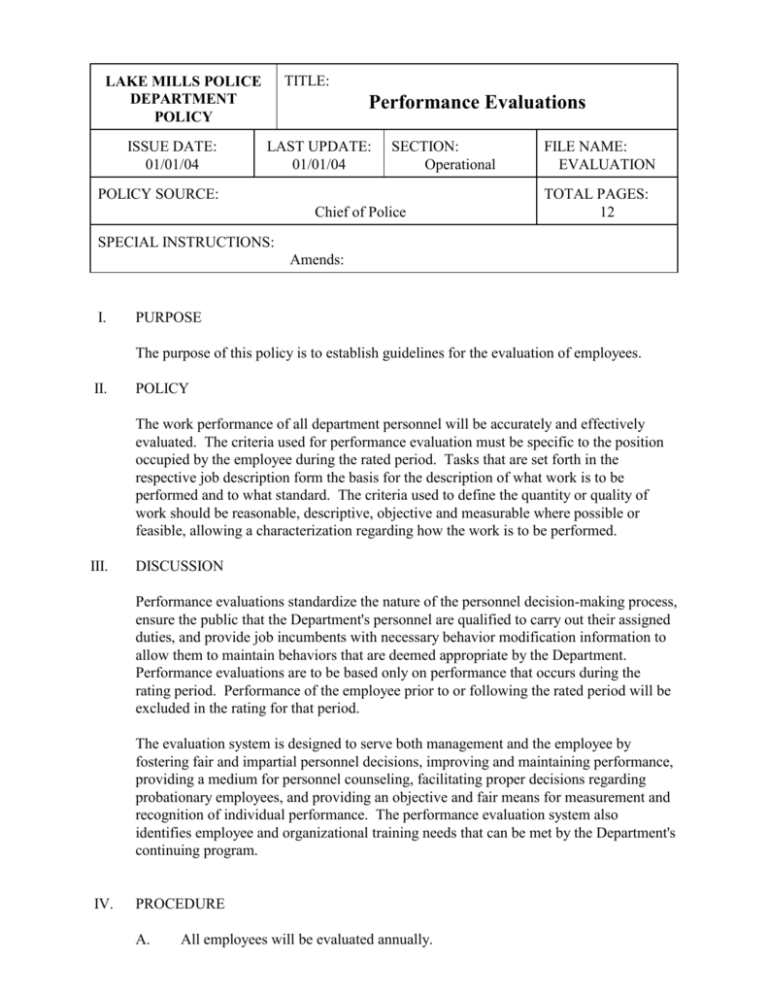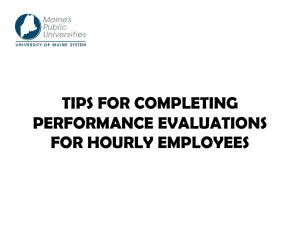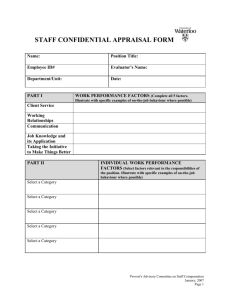EVALUATION-ok - Lake Mills Police Department
advertisement

TITLE: LAKE MILLS POLICE DEPARTMENT POLICY ISSUE DATE: 01/01/04 Performance Evaluations LAST UPDATE: 01/01/04 SECTION: Operational POLICY SOURCE: Chief of Police FILE NAME: EVALUATION TOTAL PAGES: 12 SPECIAL INSTRUCTIONS: Amends: I. PURPOSE The purpose of this policy is to establish guidelines for the evaluation of employees. II. POLICY The work performance of all department personnel will be accurately and effectively evaluated. The criteria used for performance evaluation must be specific to the position occupied by the employee during the rated period. Tasks that are set forth in the respective job description form the basis for the description of what work is to be performed and to what standard. The criteria used to define the quantity or quality of work should be reasonable, descriptive, objective and measurable where possible or feasible, allowing a characterization regarding how the work is to be performed. III. DISCUSSION Performance evaluations standardize the nature of the personnel decision-making process, ensure the public that the Department's personnel are qualified to carry out their assigned duties, and provide job incumbents with necessary behavior modification information to allow them to maintain behaviors that are deemed appropriate by the Department. Performance evaluations are to be based only on performance that occurs during the rating period. Performance of the employee prior to or following the rated period will be excluded in the rating for that period. The evaluation system is designed to serve both management and the employee by fostering fair and impartial personnel decisions, improving and maintaining performance, providing a medium for personnel counseling, facilitating proper decisions regarding probationary employees, and providing an objective and fair means for measurement and recognition of individual performance. The performance evaluation system also identifies employee and organizational training needs that can be met by the Department's continuing program. IV. PROCEDURE A. All employees will be evaluated annually. Issued: 01/01/04 Page: 2 1. The employee's performance, as defined by evaluations, provides information concerning suitability for assignment, training needs, ability to assume more responsibilities, and effectiveness in the assigned position. The evaluation report shall be a key management tool and resource for decisions pertaining to promotion, advancement, career development, training and selection for specialized assignments. 2. The performance evaluation system is based on the concept of management by objectives. A basic premise of this concept is that active participation by the rated employee results in better understood and more acceptable performance objectives. This, in turn, causes that person to be more committed and motivated to attain those objectives. 3. The objectives for every position must be clearly defined, job-related, and attainable through a reasonable amount of ability and effort. Both the employee and the supervisor must know what is expected, how the results will be measured, and must share a common concept of the desired end result. 4. Each employee shall be counseled at the beginning of the rating period concerning: 5. B. EVALUATION a. Tasks of the position occupied b. Level of performance expected c. Evaluation rating criteria While each measure of job performance should be clearly objective and quantifiable, it is recognized that some areas of a person's job are subjective in nature. Subjective standards are acceptable as long as they are well-defined, understood, and verifiable. When changes in evaluation standards occur, the reasons should be clearly communicated to all interested parties. Performance Evaluation Outline 1. Within 15 days of the beginning of the evaluation period, each member of the Department should receive a Performance Evaluation Outline based on a job description for that position. The outline will consist of a minimum of two major or key areas of responsibility. Performance standards or objectives will be included for each major area to identify priority or critical tasks or rater expectations that the employee will be evaluated on. 2. Each employee must be furnished a copy of his/her performance Issued: 01/01/04 EVALUATION Page: 3 evaluation outline. C. D. Evaluation Summary 1. Whenever an evaluation is completed, a worksheet indicating the employee's level of activity and performance for each performance measure and area of responsibility shall be completed. 2. Each performance evaluation report must be reviewed and signed by the employee, his or her supervisor, and the Chief of Police. It is imperative that each evaluation report on an employee's performance be read and understood by the employee. An employee's signature only indicates that the employee has read the report and does not imply agreement or disagreement with the contents. If the employee refuses to sign the report, the supervisor should so note and record the reason or reasons, if given. 3. All evaluations completed should ensure objectivity, fairness, quality, impartiality of ratings, and level of participation in counseling employees. 4. Supervisors should be prepared to comment on the performance in order to ensure the uniform application of ratings and to ensure the fairness and validity of the system. 5. Evaluation summaries shall contain the following information: a. Name of employee b. Position (Job Title) of employee c. Inclusive dates of evaluated period d. Signatures of employee, supervisor and Chief of Police. 6. A copy of the evaluation must be provided to the employee upon completion of the performance appraisal interview. 7. Evaluation summaries for sworn and civilian employees will be kept in each employee's personnel file. Completed performance evaluations will be retained as permanent documents. 8. Any letters of criticism documenting unsatisfactory performance should be forwarded to the Chief of Police. Prorating Standards / Work Hour Adjustments 1. A quantitative measurement of hours worked can be used to reduce the Issued: 01/01/04 EVALUATION Page: 4 objective performance standards. Total hours worked will be based on vacations, illnesses, injury, training, directed patrols and special assignments or other Department sanctioned absences versus work hours available. This gives the supervisor the ability to treat all employees the same regardless of seniority, health or work circumstances. 2. E. The standard for minimally acceptable work is thus established initially for the employee who works all available hours and is reduced proportionately for any employee who works less than the available hours. Required Reviews 1. The formal review of each employee's performance will occur annually. Informal reviews may be held as often as possible between the employee and supervisor. 2. The system is designed to evaluate an employee's recent past performance in relation to the performance measures relative to his/her job classification. This rating is a progress indication and formally provides the employee with direction. 3. Any employee that is deemed to be performing in an unsatisfactory manner, must be notified in writing at least 90 days prior to the end of the evaluation period. 4. The evaluation should be prepared to substantiate ratings at the unsatisfactory level, to advise the employee of his or her unsatisfactory performance, and to define actions that should be taken to improve his or her performance. If unsatisfactory performance continues, that should be noted at the end of the 90 day period. 5. Evaluators must substantiate ratings in the lowest or highest categories. Written comments on the evaluation report are required of evaluators who rate employees in the highest or lowest categories overall. This required narrative commentary should detail specific reasons to substantiate the ratings. 6. The employee and the evaluator must have a face-to-face interview for all evaluations. Employees may provide written comments that will be attached to their evaluation. Such comments will be forwarded to the evaluator completing the review and shall remain a part of the evaluation. This should contribute to the fairness and objectivity of the evaluation system. 7. Upon completion of the evaluation, the evaluator will deliver the Issued: 01/01/04 EVALUATION Page: 5 employee's evaluation to the Chief of Police. F. 8. The Chief of Police will conduct and document an annual inspection of the performance evaluation system. This inspection is to determine how well the system functions. The objectives of the inspection should be to identify instances of extreme ratings and the reasons for them and the number of contested appraisals and the reasons for them. 9. The necessity of meeting the evaluation completion dates is critical to the effectiveness of the system. A performance measure for evaluators will be their success or lack there of in meeting the established time frames. 10. The established completion dates for evaluations can only be exceeded in instances of appealed evaluations or cases involving exceptional circumstances. Change of Assignment or Transfer 1. H. I. Personnel who change duties during the rating period may necessitate a special or prorated performance evaluation for the previously held position. Probationary Personnel 1. Probationary employees will be evaluated under the Field Training Officer program on a bi-weekly basis. 2. The focus of evaluating probationary employees must be on determining whether or not they can perform the required work to Departmental standards and expectations and determining at the earliest possible point, whether or not they are suitable for continued permanent employment. This requires FTO’s and supervisors to closely monitor probationary personnel. Written evaluations are an integral part of this process. Performance Below Acceptable Standards 1. Employees are required and expected to consistently perform to the minimum acceptable standard or higher for all standards set forth in their respective performance evaluation. Officers whose performance is below the minimum level are subject to discipline in accordance with Department policy. Issued: 01/01/04 EVALUATION Kathleen Hansen Chief of Police Page: 6 Date: 01-01-04 Issued: 01/01/04 EVALUATION Page: 7 APPENDIX A STANDARDS APPLICATIONS PERFORMANCE EVALUATION SYSTEM USING 1 THRU 10 RATINGS Applicable for Sworn Officers, Community Service Officers, and Dispatch Staff ONE or TWO - Unacceptable Performance The employee's performance clearly and consistently fails to meet work requirements. This rating indicates inadequate and unacceptable performance. The employee shows either an unwillingness and/or an inability to improve. It characterizes an employee whose performance is substantially below the standard or objective. The employee has been on the job long enough to have shown better performance. The evaluator must counsel the employee as to he seriousness of this matter and the employee's responsibility to improve the performance as quickly as possible. The lack of productivity or the poor quality of performance is hindering others whose job interrelates with the employee. Others are forced to help carry the employee's workload. The employee has to realize that the job is not getting done. If performance continues at this low level, the employee should be replaced. Repeated counseling is ineffective. The employee does not accomplish routine as well as special assignments. Work keeps falling behind. The lack of performance is affecting the evaluator's credibility and unit integrity. The employee makes one mistake after another, often the same mistake. Constantly asks questions and advice on matters that should be common knowledge. Apparent lack of knowledge is not consistent with seniority, ability, experience, and/or training. Issued: 01/01/04 EVALUATION Page: 8 THREE to FOUR - Substantial Improvement Needed. The employee's performance often fails to meet work requirements. The employee has demonstrated some willingness or ability to improve performance, but only on occasion. This occurs mostly after performance counseling, for short periods, and is not sustained. Performance is less than satisfactory and requires that steps be taken for consistent improvement. The rating characterizes performance that is below average and is less than competent. While the performance often is poor, the employee may improve with additional counseling and/or training efforts. The employee needs some pushing and follow-through, but does the job somewhat competently under close guidance and supervision. The employee is not usually self-motivated and requires the evaluator to plan any special event or project. After such extensive briefing or planning, the project will usually be accomplished with adequate results. Others in the work group often have to "carry" the employee. Discipline may be needed to get the employee to consistent, long term minimally acceptable performance. FIVE or SIX - Achieves Expected Outcome. Performance is routinely adequate and he/she regularly meets work requirements. This rating reflects the employee's willingness and ability to meet an acceptable level of performance that is established. The performance is to standard only, although there may be brief periods of slight improvement or lack of results. The employee is doing an adequate and satisfactory job. Performance is what is expected of the employee, given the standards, and his/her seniority, experience, ability, and training background. The employee is not required to improve significantly. Errors are few and seldom repeated. The employee displays an adequate balance between quality and quantity of work and has proven capable of handling all of the routine work assignment or duties of the job. Very rarely does the officer perform beyond the scope of the normal duties. Does not seek additional responsibility. Is content to do the normal, traditional duties associated with the position. Requires normal supervision and follow-up. The employee is considered a competent member of the unit and can be given most duties with a reasonable assurance of completing them to the rater's satisfaction and standard. Issued: 01/01/04 EVALUATION Page: 9 SEVEN or EIGHT - Exceeds Standards & Objectives. Performance regularly meets and often exceeds the work requirements. The employee often exhibits a desire and ability to exceed standards that are routinely adequate and to be above the norm or average by doing more than is expected. The employee may accomplish more than expected. Is able to take on extra projects and tasks without defaulting in other activities. Each project or job attempted, is done thoroughly and routinely well. Shows initiative and is a self-starter. Performance is of uniformly high quantity and quality results. The employee does his/her own advanced planning, anticipates problems, and takes appropriate action for all routine and most special situations. Shows a good grasp of the situation beyond the apparent things. Thinks beyond the details of the job and works toward the overall objectives of the job and the Department. The employee should be given consideration for greater responsibility and/or promotion in the future. NINE or TEN - Distinguished or Unique Performance. Performance is clearly superior in meeting work requirements and demonstrates consistent exceptional desire and ability. Sets an example for others to follow. This rating characterizes an excellent employee who consistently and routinely does far more than what is expected. Demonstrates knowledge and ability beyond what could be expected for an individual with the same seniority, experience, and level of training. Recognized as an expert in a particular job area. The performance and actions display a complete understanding of assigned duties and special projects or assignments. Requires little or no supervision. Invariably takes the best approach for getting the job done right with routinely commendable results. Routinely volunteers for projects and special assignments. Does well in all without hurting high performance of generally assigned duties. The guidelines established above must be used by evaluators in applying actual numerical ratings to subject standards. The language should be taken somewhat literally in order to accurately reflect the individual's performance in terms of behavior and adherence to the established performance criteria. In a further sense, the guidelines can be applied to an Area of Responsibility and also, to the overall evaluation. In order to rate in the overall sense, the rater must rate individual standards in the same manner throughout the final rating process. Issued: 01/01/04 EVALUATION Page: 10 APPENDIX B STANDARDS APPLICATIONS PERFORMANCE EVALUATION SYSTEM USING .5 THRU 2.0 RATINGS 0 Failed to Meet Goal (Serious deficiencies and is well below full performance standards; failed to meet almost all of measurement criteria.) .25 .50 Partially Met Goal (Meets standards in some respects but generally at a less than satisfactory level; employee failed to meet one or more of the measurement criteria.) .75 1.00 Met Goal (Performance meets job standards; Employee did what was required meeting all measurement criteria considered. 1.25 1.50 Exceeded Goal (Performance exceeded job standards; employee exceeded one or more of the measurement criteria considered.) 1.75 2.00 Substantially Exceeded Goal (Performance greatly exceeds job standards; employee greatly exceeded expectations on almost all measurement criteria considered; accomplishment of the objective is significantly above standards set.) MEASUREMENT CRITERIA 1 - QUALITY: Consider accuracy, clarity, thoroughness, acceptability, usefulness of results, whether standards or specifications were met, efficiency. 2 - QUANTITY: Volume, how much, how many. 3 - TIMELINESS: Deadlines met, turnaround time, promptness. 4 - MANNER OF PERFORMANCE: 5 - COST EFFECTIVENESS: Methods utilized, how objective was accomplished, reaction of others affected. Cost savings, staying within budget guidelines or parameters. Issued: 01/01/04 OTHER: EVALUATION Page: 11 Consider any other methods of measuring performance that do not fall under the above criteria. Issued: 01/01/04 EVALUATION Page: 12 APPENDIX C STANDARDS APPLICATIONS PERFORMANCE EVALUATION USING BEHAVIORALLY-ANCHORED SCALE SUCCESSFUL: Represents good, solid performance and job knowledge. Errors are few and not repeated. SUCCESSFUL WITH IMPROVEMENT NEEDED: Overall performance in a specific job element is successful but there is an identifiable need to address a specific performance concern that is explained to the employee by the evaluator. Failure by the employee to make the improvement by the next evaluation period may result in an unsuccessful rating. UNSUCCESSFUL: Reflects inadequate, unacceptable performance. (See specific behaviorally-anchored rating scales for each type of rated job position and each major area of responsibility that applies to that position.) PERFORMANCE EVALUATION SYSTEM ASSIGNMENTS BY JOB POSITION ONE THRU TEN RATING SCALE: Community Service Officer(s) Sworn Officers Dispatch Staff .5 THRU 2.0 RATING SCALE: (City Of Lake Mills) Sergeants BEHAVIORALLY-ANCHORED RATING SCALE: Sworn and Dispatch personnel Community Service Officer(s)





